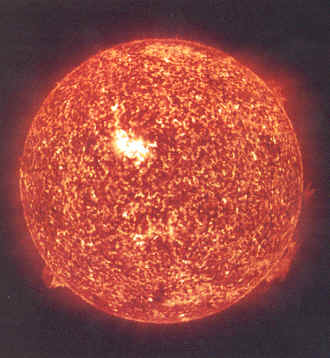

The Earth resides in an area called the habitable zone of the solar system. It formed close enough to the sun whereas it was constructed mostly from solids, as opposed to the jovian planets from Jupiter to Neptune, which have no landmasses, crusts or oceans. Being one of the terrestrial planets, Earth was able to get all three, which is one of the necessities for complex life.
If Earth had formed too close to the sun, from about Mercury to Venus, tidal lock would be the chief concern after the obvious problem of tremendously hot temperatures, which would be too extreme for complex life to evolve. Planets too close to the sun usually have slower rotation rates as compared to revolution rates, and suffer from tidal lock. This is where the rotation rate of a planet is slow enough where one side of the planet is constantly facing the sun during its orbit. This creates super-hot temperatures on the sunward face, while the other side suffers from the opposite extreme, and is constantly very, very cold.
Had Earth formed in the area of the Asteroid Belt between Mars and Jupiter, complex life could once again not evolve. Carbon and water levels are extremely high in that area. Peter Ward and Donald Brownlee in their book Rare Earth explain that water and carbon levels in these asteroids are about 20% and 4%, respectively, as compared to Earthís .1% and .05% respectively. (46) With water and carbon at these high levels, Earth would have been covered almost completely in ocean, and carbon dioxide would dominate the atmosphere, ďproduc[ing] Venus-like surface temperatures of hundreds of degrees Celsius, and the surface would have been too hot forÖliving organisms to survive.Ē (47)
As previously mentioned, Earth formed from Jupiterís position outward would lack any type of surface and oceans, and would be composed mainly from gasses, like the jovian planets. Because of a lack of solids, plate tectonics cannot exist, which are also essential for life. Furthermore, the average temperature of the planet would be far too low for complex life to survive.
As it is, Earth is in the right position to avoid all of these major problems. It is far enough to avoid tidal lock, and the extreme temperatures of the sun. It is far enough too have a large amount of ocean on the surface, but it is close enough to avoid having too much ocean, covering continental landmasses. It is also close enough so as to be able to have landmasses, warm temperatures and plate tectonics, all of which are needed for complex life to exist.
-K. Smith
At our current tilt, the sunís radiation is distributed between 23.5 degrees north and south throughout the year, between the Tropic of Cancer (on the summer solstice) and the Tropic of Capricorn (on the winter solstice), respectively, and at the equator during the autumnal and spring equinoxes. The sunís highest position in terms of degrees is the same number as the planetís axis tilt. Thus, a planet with a tilt at 0 degrees has the sun over the equator at all times. A planet with a 45 degree tilt has the sunís radiation between 45 degrees north and south throughout the year.
Seeming as the sunís radiation is never heavily distributed in one place on the Earthís surface for an extended amount of time, temperatures stay warm enough around the majority of the planet throughout the year to support complex life, and we still retain our polar ice caps as the sun never goes high enough in latitude to melt them.
If Earthís axis tilt were at 0 degrees, the sunís radiation would constantly beat down over the equator, resulting in extremely high temperatures over this region throughout the entire year. Peter Ward and Donald Brownlee explain in their book, Rare Earth, that polar ice caps can still exist on a planet with a 0 degree tilt, which is proven on the planet Mercury (223-4). On a planet such as this, the habitable zone would be significantly less than we currently have now, existing in a northern and southern area between the equatorial region and the arctic regions, as the equator and surrounding area would have temperatures far too high to support complex life.

If Earthís axis tilt was 90 degrees, as shown above, the results would be the same as with a 0 degree tilt, simply with the super-hot region being from the north pole around to the south pole over the prime meridian, as opposed to the equator (224). A planet tidally locked with a 90 degree axis tilt close to the sun would have one of the poles constantly super heated, shown as the white part of the above diagram, with a very small circular habitable zone around the pole, but below the equator, as shown in gray on the diagram. The back half of the planet, beyond the equator would be completely frozen over and no sunlight would ever touch the surface of the planet. This could result in the coldest temperatures ever found in the solar system (VanLeer).
If a planet is to develop complex life forms, a planetís axis tilt is a delicate and important issue. Earthís tilt is about as perfect as it could get. The sunís radiation is distributed over a wide area of the planet, which does not allow for temperatures to become super-heated in any region. Temperatures stay warm for the majority of the planet, while still allowing for polar ice caps to exist. If either of the two extremes had occurred, human beings would probably not exist, as temperatures would have been too hot in some areas and not warm enough in others.
-K. Smith